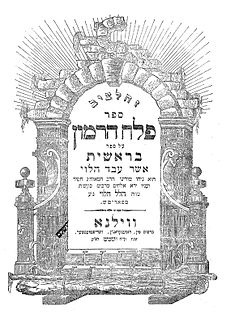Related Research Articles

Chabad, also known as Lubavitch, Habad and Chabad-Lubavitch, is an Orthodox Jewish Hasidic movement. Chabad is one of the world's best-known Hasidic movements, particularly for its outreach activities. It is one of the largest Hasidic groups and Jewish religious organizations in the world.

Menachem Mendel Schneersohn also known as the Tzemach Tzedek was an Orthodox rabbi, leading 19th-century posek, and the third Rebbe of the Chabad Lubavitch Hasidic movement.

Shneur Zalman of Liadi, was an Orthodox rabbi and the founder and first Rebbe of Chabad, a branch of Hasidic Judaism, then based in Liadi in the Russian Empire. He was the author of many works, and is best known for Shulchan Aruch HaRav, Tanya, and his Siddur Torah Or compiled according to the Nusach Ari. Zalman is a Yiddish variant of Solomon and Shneur is a Yiddish composite of the two Hebrew words "shnei ohr".

Schneersohn is a Jewish surname used by many of the descendants of the Rabbi Shneur Zalman of Liadi, the first Rebbe of the Chabad-Lubavitch Hasidic movement.

The Tanya is an early work of Hasidic philosophy, by Rabbi Shneur Zalman of Liadi, the founder of Chabad Hasidism, first published in 1797. Its formal title is Likkutei Amarim, but is more commonly known by its opening word, Tanya, which means "it was taught in a beraita". It is composed of five sections that define Hasidic mystical psychology and theology as a handbook for daily spiritual life in Jewish observance.

Sholom Dovber Schneersohn was the fifth Rebbe of the Chabad Lubavitch chasidic movement. He is known as "the Rebbe Rashab".
Dovber Schneuri was the second Rebbe of the Chabad Lubavitch Chasidic movement. Rabbi Dovber was the first Chabad rebbe to live in the town of Lyubavichi, the town for which this Hasidic dynasty is named. He is also known as the Mitteler Rebbe, being the second of the first three generations of Chabad leaders.

770 Eastern Parkway, also known as "770", is the street address of the World Headquarters of the Chabad-Lubavitch Hasidic movement, located on Eastern Parkway in the Crown Heights section of Brooklyn, New York, in the United States. The building is the center of the Chabad-Lubavitch world movement and considered by many to be an iconic site in Judaism.

Tomchei Temimim is the central Yeshiva of the Chabad-Lubavitch Hasidic movement. Founded in 1897 in the town of Lubavitch by Rabbi Sholom Dovber Schneersohn, it is now a worldwide network of institutions of advanced Torah study. Tomchei Tmimim is also viewed by its students and teachers as a spiritual order. Students in Tomchei Tmimim acquire the title "Tamim" and the adage goes "Once a Tamim, always a Tamim."

Strashelye, is an extinct branch of the Chabad school of Hasidic Judaism, named after the town Strashelye in the Mohilev Province of present-day Belarus, where its leader lived. Like all Hasidism it is based on the teachings and customs of Chasidut as taught by the Baal Shem Tov, in turn based on the Kabbalistic works of Rabbi Isaac Luria.

Noahidism or Noachidism is a monotheistic belief system. A branch of Judaism, it is based upon the Seven Laws of Noah and their traditional interpretations within Rabbinic Judaism. According to the Jewish law, non-Jews (Gentiles) are not obligated to convert to Judaism, but they are required to observe the Seven Laws of Noah to be assured of a place in the World to Come, the final reward of the righteous. The divinely ordained penalty for violating any of these Noahide Laws is discussed in the Talmud, but in practical terms it is subject to the working legal system which is established by the society at large. Those who subscribe to the observance of the Noahic Covenant are referred to as B'nei Noach or Noahides. The modern Noahide movement has been founded by rabbis from Israel, mainly tied to Chabad and religious Zionist organizations.

The Kopust branch of the Chabad Hasidic movement was founded in 1866 by Rabbi Yehuda Leib Schneersohn after the death of the third rebbe of Chabad, Rabbi Menachem Mendel Schneersohn. The movement is named after the town Kopys in the Vitebsk Region of present-day Belarus, where Rabbi Yehuda Leib Schneersohn settled after his father's death.

Hillel HaLevi Malisov of Paritch, a levite by birth, commonly known as Reb Hillel Paritcher (1795-1864) was a famous Orthodox Jewish Chabad Rabbi in Russia. Specifically, he served as a Mashpia and communal rabbi in the towns of Paritch (Parwich), near Minsk, Russia, and Bobroisk, Belarus. He was considered exceptional in his scholarship and piety, and is referred to as a Tzadik, and even as a "half Rebbe."
Orthodox Jewish outreach, often referred to as Kiruv, is the collective work or movement of Orthodox Judaism that reaches out to non-Orthodox Jews to encourage belief in God and living according to Orthodox Jewish law. The process of a Jew becoming more observant of Orthodox Judaism is called teshuva making the "returnee" a baal teshuva. Orthodox Jewish outreach has worked to enhance the rise of the baal teshuva movement.

Maamarim/Ma'amorim in Chabad Hasidism are the central format texts of in-depth mystical investigation in Hasidic thought. In Chabad philosophy, the textual format of the Maamar is used in a great number of published works.
Aaron HaLevi ben Moses (Hurwitz) of Staroselye was a Talmudic scholar and Kabbalist of note, who lived in Poland during the latter part of the eighteenth century and the early part of the nineteenth.

Rabbi Shmaryahu Noah Schneersohn (1842-1924) was the fourth and last rebbe of Kopust, a branch of the Chabad Hasidic movement. Rabbi Shmaryahu Noah succeeded his brother, Rabbi Shalom Dovber Schneersohn as 4th leader of the group for a period of time after Rabbi Shalom Dovber died. Other sources claim Rabbi Shmaryahu Noah succeeded his brother, Rabbi Shlomo Zalman Schneersohn as leader of the group in the year 1900 after Rabbi Shlomo Zalman died. Rabbi Shmaryahu Noah served as the Kopuster movement's rebbe in the town of Babruysk. He was rav of the chasidim in Babruysk from 1872, and founded a yeshiva there in 1901. He authored a two-volume work on Hasidism, titled "Shemen LaMaor".

Chabad offshoot groups are those spawned from the Chabad Hasidic Jewish movement. Many of these groups were founded to succeed previous Chabad leaders, acting as rivals to some of the dynastic rebbes of Chabad. Others were founded by former students of the movement, who, in forming their own groups, drew upon their experiences at Chabad.
References
- ↑ Ehrlich, Avrum. The Leadership of Dovber. Leadership in the Habad Movement. (Chapt. 11). Jerusalem: Jason Aronson, 2000. https://www.academia.edu/1316532/Leadership_in_the_Habad_Movement
- ↑ Beck, Atara. "Is Chabad Lubavitch". Jerusalem Post. August 16, 2012. http://www.jpost.com/Magazine/Judaism/Is-Chabad-Lubavitch